![]()
![]()
![]()
Use LEFT and RIGHT arrow keys to navigate between flashcards;
Use UP and DOWN arrow keys to flip the card;
H to show hint;
A reads text to speech;
28 Cards in this Set
- Front
- Back
|
what are members of the family Enterobacteriaceae found in the body
|
intestines
|
|
|
macConkey is a selective medium
|
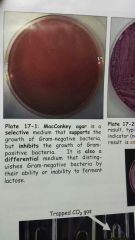
Because it inhibits gram positive bacteria growth
supports gram negative enteric bacilli |
|
|
macConkey is a differential medium because
|
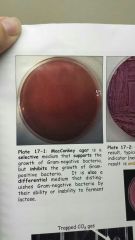
contagious the indicator neutral red which distinguishes whether bacteria ferment lactose or not
|
|
|
coliform bacteria
|
coliforms are nonpathogenic enterics that do not normally cause serious illness
presence on foods or water indicate pathogenic organisms of fecal origin may also be present |
|
|
nonpathogenic Gram negative bacilli on MacConkey agar
|
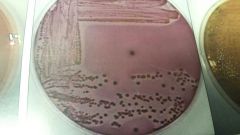
deep pink colonies= lactose ferment (coliform)
|
|
|
pathogenic gram negative enteric bacteria on MacConkey agar
|
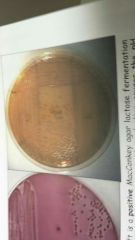
colorless colonies= lactose nonferment
|
|
|
small inverted tube in glucose broth (gram negative bacilli)
|
Durham tube, traps CO2 bubbles given off during glucose fermentation
|
|
|
indicator in carb. ( glucose and fructose)
|
phenol red ( deep red at>6.8, yellow. at <6.8)
|
|
|
plus circled
|
two tests glucose with Durham test tube and middle reading of TSI tube testing
it means acid production with gas |
|
|
acidic means phenol red
|
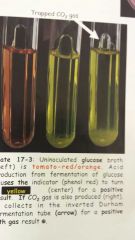
yellow = positive
|
|
|
3 carbs in TSI agar and percentage.
|
.1 glucose 1 lactose 1 sucrose
|
|
|
TSI aerobic/anaerobic
|
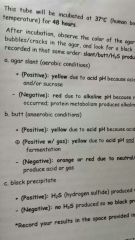
slant aerobic/ butt anaerobic
|
|
|
iron salts (ferrous sulfate) in TSI medium
|
H2S hydrogen sulfide = black percipitate called ferric sulfide Fe2S3
|
|
|
when recording TSI what do slashes mean
|
fermentation of lactose/&or glucose in aerobic condition/
fermentation of glucose to produce gas in anaerobic condition H2S production in aerobic condition (if black/+ assume glucose production +) |
|
|
IMViC
|
Indole Methyl red Voges proskauer Citrate tests
|
|
|
indole test
|
if enzyme tryptophanase present (indicate presence of indole)
|
|
|
added to inoculated and incubated indole medium
|
Kovacs reagent
|
|
|
phosphate buffer
|
MR VP
|
|
|
methyl red test indicator
|

methly red
positive when do much acid over populate buffered system added after incubation and is toxic red= 4.4 positive orange= 4.4 to 6 further incubation yellow= 6 negative |
|
|
positive methyl red
|
deep red ph <4.4
|
|
|
reagent added to an inoculated and incubated Voges Proskauer test
|
a naphthol (Barrets reagent a) 40 koh (Barritts reagent b)
|
|
|
positive Vogues Proskauer
|
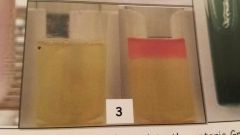
aceton presence reddish color (methyl red pH <4.4)
|
|
|
indicator in Citrate test
|
bromthymol blue ( blue at pH >7.6)
positive bacterial growth: blue, pH >7.6, alkaline from breakdown of citrate, only vacteria with citrase can grow bc citrate is the only source of carbon |
|
|
citrate utilization test indicates whether or not the bacteria makes
|

the enzyme citrase and thus can utilize the only carbon source available aerobically
|
|
|
urease test indicates whether or not the bacterium makes
|
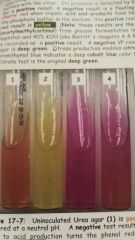
the enzyme urease to break down urea. this forms ammonia (alkaline) raising the pH (phenol red) turning hot pink
|
|
|
why is the motility medium a gel
|
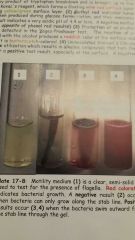
motile bacteria possessing flagella are able to move through the gel.
|
|
|
how do you explain a negative test result that should be positive
|
not inoculated
needle/loop too hot=dead microbes |
|
|
how to explain a positive result that should be negative
|
contamination
|

